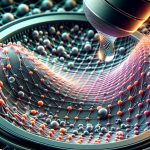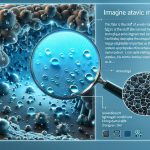You might not know that nanotechnology has the potential to make your clothes stain-resistant without sacrificing breathability. Imagine fabrics that repel water but still feel comfortable and flexible. With nanoparticles, textiles can now regulate temperature, making them perfect for any weather. These advancements don't just stop at comfort; they also enhance durability and extend the lifespan of your garments. Curious about how these smart textiles can even monitor your health or convert energy? Let's explore how nanotechnology is transforming fabric performance in ways you never imagined.
Table of Contents
Key Takeaways
- Nanoparticles enhance stain resistance by preventing deep penetration and reducing harsh cleaning agents' usage.
- Advanced moisture management and thermal insulation offer superior temperature regulation in various conditions.
- Nano-coatings create hydrophobic surfaces that repel water while maintaining fabric breathability.
- Nanotechnology boosts fabric durability by improving tear resistance and maintaining elasticity.
- Smart textiles incorporate technology for health monitoring and respond to environmental stimuli.
Stain Resistance
With nanotechnology, fabric can now resist stains like never before. You'll appreciate how this advancement enhances both fabric longevity and soil repellency. By integrating nanoparticles into the fabric, manufacturers have crafted materials that actively repel liquids and dirt.
Imagine having a shirt that shrugs off coffee spills or a sofa that resists muddy paw prints with ease. It's not merely about avoiding stains but maintaining the pristine look and feel of your fabrics over time.
You're not just getting a temporary fix; the benefits are built into the very fibers of the fabric. This means you'll enjoy longer-lasting garments and furnishings that look new, wash after wash.
The nanoparticles create a barrier that prevents stains from penetrating deeply, ensuring that your fabrics remain vibrant and intact. This advanced soil repellency reduces the need for frequent washing and harsh cleaning agents, which can degrade fabric quality over time.
In essence, nanotechnology empowers you to maintain your fabrics in peak condition effortlessly. Mastery over fabric care is within your reach, enabling you to focus on enjoying your stylish, durable possessions without the constant worry of stains and wear.
Temperature Regulation
Nanotechnology is revolutionizing temperature regulation in fabrics, guaranteeing you stay comfortable regardless of the weather. Imagine you're out on a scorching summer day or braving a chilly winter evening, and your clothing adapts seamlessly to maintain ideal body temperature.
With advanced nanotech, fabrics now offer superior moisture management and breathability. These innovations help wick away sweat from your skin, keeping you dry and preventing that clammy feeling.
By integrating nanotechnology, fabrics achieve exceptional thermal insulation without adding bulk, allowing you to remain comfortable whether it's hot or cold. The precise engineering at the nanoscale level enables these materials to trap air effectively, providing the warmth you need in colder climates.
Conversely, these fabrics can also facilitate airflow, enhancing breathability to keep you cool when temperatures rise.
Moreover, the incorporation of nanomaterials ensures a balanced and consistent thermal environment, enhancing overall comfort. You don't just wear clothes; you experience a new level of adaptability that adjusts to your body's needs.
With nanotechnology, clothing becomes an active participant in regulating your body temperature, making traditional materials seem outdated and cumbersome. Mastering this innovative fabric technology means you're always prepared, whatever the weather.
Water Repellency
Imagine your clothes repelling water effortlessly, thanks to nano-coatings. These coatings not only enhance the durability of fabrics but also raise questions about their environmental impact.
You'll discover how nanotechnology can revolutionize your wardrobe while balancing sustainability concerns.
Nano-coatings for Fabrics
By applying nano-coatings to fabrics, you can achieve remarkable water repellency without compromising the material's breathability. This advanced technique involves nano particles application that attaches tiny particles to the fabric surface, creating a barrier against water. These nano particles are engineered to modify the fabric surface to repel water molecules, allowing the fabric to stay dry even during heavy rains.
These nano-coatings not only make the fabric water-resistant but also enhance its overall performance. Here are four key benefits:
- Enhanced Water Repellency: Nano-coatings create a hydrophobic surface that effectively repels water and other liquids.
- Maintained Breathability: Unlike traditional waterproof treatments, nano-coatings allow air to pass through, making sure the fabric remains breathable.
- Stain Resistance: The same properties that repel water also help fabrics resist stains, making them easier to clean.
- Long-lasting Effectiveness: Nano-coatings offer durable water repellency, preserving their effectiveness through multiple washes.
Mastering the use of nano-coatings for your fabrics guarantees they perform at their best, whether you're designing high-performance sportswear or everyday clothing. By focusing on nano particles application and fabric surface modification, you can create textiles that meet the highest standards of functionality and comfort.
Enhanced Durability Features
When nano-coatings are applied to fabrics, they greatly enhance durability by improving water repellency and maintaining the material's integrity over time. You'll notice a significant upgrade in fabric strength and abrasion resistance, ensuring your textiles withstand everyday wear and tear effortlessly. Imagine never worrying about spills or stains again because your fabric repels water like a duck's back.
Nano-coatings create a protective barrier that keeps water molecules from penetrating the fabric. This means your clothes, outdoor gear, or upholstery will stay dry and pristine for much longer.
| Feature | Emotional Impact |
|---|---|
| Water Repellency | Confidence |
| Enhanced Fabric Strength | Peace of Mind |
| Abrasion Resistance | Satisfaction |
| Longevity | Joy |
| Reliable Performance | Trust |
Environmental Impact Considerations
While nano-coatings significantly enhance fabric durability, they also raise important questions about their environmental impact, particularly regarding water repellency. These advanced coatings often contain chemicals that aren't biodegradable, posing long-term environmental risks.
To address these concerns, you should consider eco-friendly alternatives and sustainability measures.
Here are four critical steps you can take to minimize environmental impact:
- Choose Biodegradable Coatings: Opt for water-repellent nano-coatings that decompose naturally over time, minimizing their ecological footprint.
- Implement Recycling Options: Guarantee that fabrics treated with nano-coatings can be recycled, reducing waste and promoting a circular economy.
- Adopt Sustainable Manufacturing Practices: Concentrate on production methods that consume less energy and produce fewer emissions, aligning with sustainability measures.
- Research and Development: Invest in R&D to explore new materials and methods that offer both high performance and low environmental impact.
Enhanced Durability
You'll be amazed at how nanotechnology boosts fabric durability.
It increases tear resistance and enhances wear lifespan, making your clothes last longer.
Imagine not having to replace your favorite items as frequently!
Increased Tear Resistance
By integrating nanotechnology into fabrics, manufacturers greatly boost tear resistance and enhance overall durability. You'll find that nanotechnology improves tear strength by reinforcing the fabric at a microscopic level. This results in textiles that can withstand greater tensile forces without tearing. Imagine having clothing or gear that resists wear and tear much better than anything you've used before.
Nanotechnology doesn't just make fabric tougher; it transforms it. Here are four ways nanotechnology enhances fabric durability:
- Enhanced Fiber Strength: Nanoparticles bond with fabric fibers, making them stronger and less prone to breakage.
- Micro-Level Reinforcement: Nanocoatings provide a protective layer that shields the fabric from external stresses.
- Improved Flexibility: Fabrics treated with nanotech maintain their elasticity, reducing the likelihood of tears when stretched.
- Abrasion Resistance: Nano-enhanced fabrics resist surface wear, keeping them intact longer.
Improved Wear Lifespan
Nanotechnology vastly extends the wear lifespan of fabrics, ensuring your clothing and gear last much longer. By integrating advanced materials at a microscopic level, you can notably reduce friction, which is a major factor in fabric degradation. These innovations mean your garments won't just look good longer—they'll maintain their structural integrity, too.
Imagine a world where your favorite jacket or pair of jeans doesn't succumb to the usual wear and tear. With nanotechnology, this is now a reality. The advanced materials used in these fabrics create a barrier against abrasion, making them more resistant to everyday friction. You'll notice the longevity benefits immediately; your clothing remains in top condition, requiring fewer replacements and saving you money over time.
Moreover, wearable technology embedded with nanotechnology offers unprecedented durability. Whether it's a smartwatch band or a fitness tracker, the enhanced resilience means these devices can endure more rigorous use without deteriorating.
This isn't just about longevity benefits; it's about maintaining peak performance. Embrace nanotechnology, and transform your wardrobe and gear into longer-lasting, more reliable companions. This is the future of fabric performance, and you can be at the forefront of it.
Lightweight Materials
In the domain of lightweight materials, nanotechnology empowers the creation of fabrics that are both incredibly light and exceptionally strong. By integrating nanomaterials, you can produce textiles with enhanced fabric breathability and moisture-wicking properties. This not only guarantees comfort but also promotes eco-friendly manufacturing and sustainable sourcing.
Nanotechnology revolutionizes the way lightweight fabrics are produced, making them more efficient and practical for everyday use. Specifically, it allows you to achieve the following:
- Enhanced Strength: Nanomaterials like carbon nanotubes add tensile strength without compromising weight, making your fabrics resilient and long-lasting.
- Improved Fabric Breathability: Nanoparticles create microscopic pores that boost ventilation, keeping you cool and dry.
- Superior Moisture Wicking: Advanced nanocoatings can actively draw sweat away from your skin, enhancing comfort during intense activities.
- Eco-Friendly Manufacturing: The use of nanotechnology minimizes waste and energy consumption, contributing to a more sustainable production process.
These innovations guarantee that you're getting the best of both worlds: lightweight materials that don't sacrifice durability or functionality. By embracing nanotechnology, you're paving the way for a future where high-performance fabrics aren't only possible but also environmentally responsible.
Smart Textiles
Smart textiles are revolutionizing the clothing industry by embedding technology into fabrics to offer advanced functionalities like health monitoring and interactive features. Imagine wearing a shirt that can monitor your heart rate, or a jacket that can charge your smartphone. These capabilities are made possible through conductivity control, enabling fabrics to transmit electrical signals efficiently.
By harnessing energy harvesting, your garments can convert ambient energy into usable power. This means your clothing could potentially power small devices, reducing the need for external batteries. The integration of nanotechnology plays an essential role here, enhancing the fabric's ability to manage and store energy without compromising comfort or flexibility.
Interactive design is another groundbreaking aspect of smart textiles. These fabrics can respond to environmental stimuli, such as changes in temperature or light, and adapt accordingly. This not only improves user experience but also opens up new possibilities for customizable clothing. For instance, a shirt could change its color based on your mood or the weather.
Incorporating these advanced features requires a deep understanding of materials science, electronics, and human-centered design. By mastering these elements, you can create smart textiles that aren't only functional but also enhance the user's lifestyle in unprecedented ways.
Frequently Asked Questions
How Does Nanotechnology Impact the Environmental Sustainability of Fabrics?
A stitch in time saves nine. You'll find that eco-friendly innovations in nanotechnology enhance the sustainable fashion industry by reducing waste and energy use, making fabrics more durable and environmentally sustainable.
What Are the Health Implications of Wearing Nanotechnology-Enhanced Clothing?
When considering health risks and safety concerns, you should know that wearing nanotechnology-enhanced clothing might expose you to nanoparticles. These could potentially penetrate your skin and cause unknown health effects, necessitating more research and regulation.
Can Nanotechnology in Fabrics Affect Their Biodegradability?
You might wonder if nanotechnology-enhanced fabrics affect their biodegradability. Indeed, integrating nanomaterials can alter how fabrics break down. It's important to balance enhanced performance with environmental impact to guarantee responsible textile innovation.
What Are the Costs Associated With Producing Nanotechnology-Enhanced Textiles?
When analyzing the costs, you'll find that producing nanotechnology-enhanced textiles involves significant investment. However, production efficiency can offset initial expenses, potentially leading to long-term savings. Accurate cost analysis guarantees you're making informed financial decisions.
Are There Any Regulatory Concerns Regarding the Use of Nanotechnology in Fabrics?
You're right to take regulatory concerns into account. Ensuring fabric safety is paramount, and agencies scrutinize nanotechnology's impact on health and environment. Stay informed about evolving standards to maintain compliance and protect consumers.
- How Is Angora Wool Made? From Rabbit to Runway - July 2, 2025
- Angora Fabric 101: Everything You Need to Know - July 2, 2025
- What Is Angora Fabric? a Complete Guide to This Luxurious Wool - July 2, 2025







